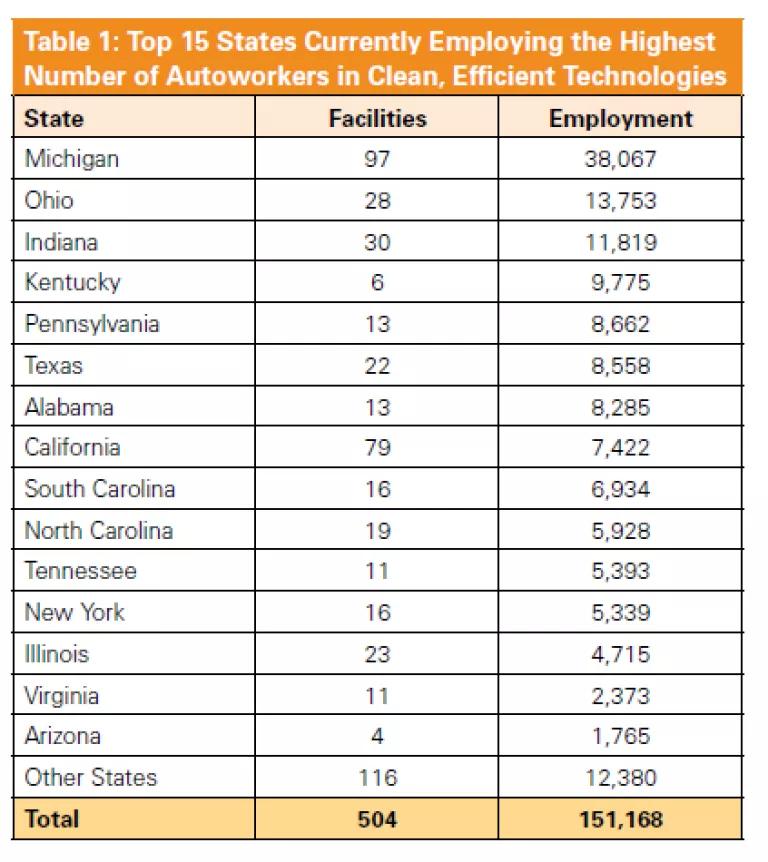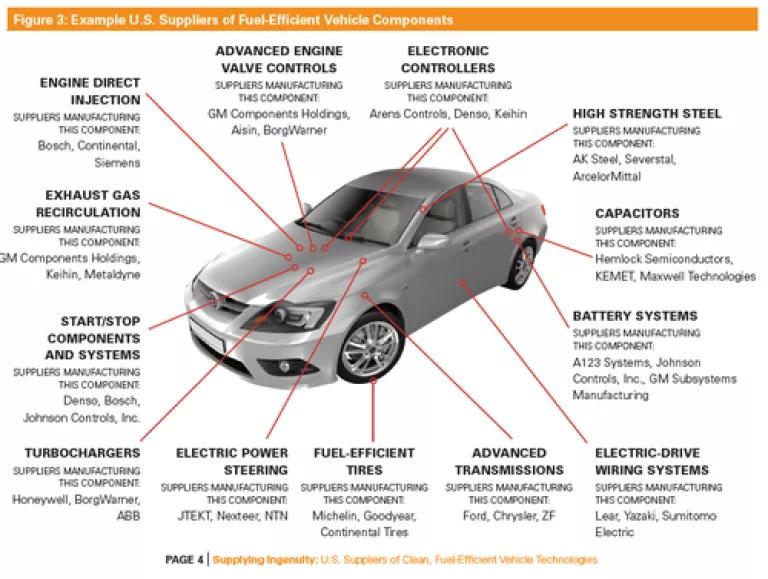
Today, the UAW, NRDC, and National Wildlife Federation is releasing a new report, “Supplying Ingenuity: U.S. Suppliers of Clean, Fuel-Efficient Vehicle Technologies”, that demonstrates that stronger pollution and fuel economy standards are already helping to drive employment in the auto industry. As my colleague Luke Tonachel's blog describes in more detail, our study identifies more than 300 companies located in 43 states and the District of Columbia that are responsible for employing more than `150,000 workers directly and for employing hundreds of thousands of others indirectly.
With the Obama’s Administration new proposal to raise standards to 54.5 mpg driving even more investment in clean car technologies, the top three states in clean vehicle jobs, Michigan, Ohio and Indiana, are poised to be the hub for this growing industry. California, which leads in the number of clean supplier facilities, is well positioned to challenge the Midwest for clean vehicle supplier leadership.
150,000 Jobs Nationwide in Clean Vehicle Supplier Industry
The companies identified in our study develop and supply the critical components for advanced internal combustion engines and vehicles, hybrid powertrains, plug-in electric vehicles, and electric vehicle charging infrastructure.
- There are more than 300 companies with 504 facilities located in 43 states and the District of Columbia supplying clean vehicle technologies.
- Currently, clean vehicle component suppliers account for 36 percent of the jobs in the automotive supplier industry and employ 155,000 workers.
Clean Car Cluster in Midwest, California Poised for Growth
The Midwest is poised to be the Silicon Valley of the clean vehicle industry, with the top three states in clean vehicle supplier jobs being Michigan, Ohio and Indiana.

- 41 percent of the supplier jobs and 31 percent of the facilities are located in Michigan, Ohio and Indiana.
- Michigan and California rank numbers 1 and 2 in clean vehicle supplier facilities, demonstrating that innovation is flourishing in these two auto-centric states.
- Michigan may be in the pole position for future growth. According to the Clean Energy Patent Index: 2010 Year in Review, Michigan leads all other states in most U.S. clean energy patents granted from 2002 to 2007.
Strong Standards will Drive up to 150,000 New Domestic Jobs Economy-wide by 2021
The Obama’s Administration new proposal to raise standards to 54.5 mpg by 2025 will drive even more investments in clean vehicle technologies. As described in my earlier blog, the set of technologies will be the same as evaluated in “Supplying Ingenuity”: efficient conventional gasoline vehicles, hybrids, plug-in electric vehicles and high-strength, lightweight materials. The difference will be there will be even more demand for these technologies and an increasing focus on advanced vehicle components, such as batteries, electric motors, and new materials.
According to NHSTA, the proposed standards for model years 2017 to 2025 will result in a fuel efficiency level of 40.9 mpg in model year 2021. In a previous study released in 2010, “Driving Growth: How Clean Cars and Climate Policy Can Create Jobs” (published jointly by the UAW, the Center for American Progress, and the Natural Resources Defense Council), showed that up to 150,000 new domestic jobs could be created in the automotive sector with a fuel economy level of 40.2 mpg, consistent with the 2021 standard level under the latest proposed standards. The report makes it clear that the number of these jobs that will be domestic will be influenced by other U.S. industrial policies, such as continuation of the Section 136 Advanced Technology Vehicle Manufacturing retooling loans.
The job growth figure in “Driving Growth” is not directly comparable to the job supplier number in “Supply Ingenuity” report since the former also includes jobs in direct automobile production, the broader supply chain (including raw materials and intermediate goods), and some nonmanufacturing jobs. However, clearly a large proportion will be in the auto supplier sector since of the nearly 700,000 jobs directly employed in the auto industry, 427,000 of those jobs are with suppliers.
In UAW’s own words: Stronger Standards, More Technology, More Jobs
Clean vehicle jobs are here today, in almost every state, and with stronger standards, poised for growth. UAW’s Barbara Somson stated it best in a March testimony before the Congress:
The simple equation for understanding how this job creation occurs is that the new technology required to meet tailpipe emissions standards represents additional content on each vehicle, and bringing that additional content to market requires more engineers, more managers, and more construction and production workers. [Testimony of Barbara Somson, UAW, before the Senate, March 17, 2011]

